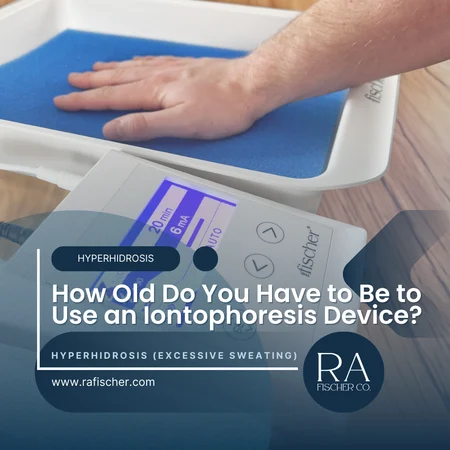September 21, 2023
By
Daniel Moyer
How Old Do You Have to Be to Use an Iontophoresis Device?
Parents often ask, “How old do you have to be to use an iontophoresis device?” The answer depends on the device’s design and safety features. Fortunately, The Fischer tap water iontophoresis device is approved for pediatric hyperhidrosis patients as young as six years old.
How Old to Use Iontophoresis Device
Safeguards Make Iontophoresis Safe for Kids
Why Metal-Free Iontophoresis is Safer
Traditional iontophoresis devices with metal electrodes can cause problems such as skin burns and the release harmful metal ions into water during treatment. For this reason, The Fischer uses silicone-graphite electrodes instead.
There are several benefits to these electrodes, including:
Read more: The Fischer vs. Competition
There are several benefits to these electrodes, including:
- No metal burns: Eliminates the risk of open-metal contact.
- Hypoallergenic material: Safe for children with skin sensitivities or metal allergies.
- Durable and effective: Graphite does not release metal ions into the skin, ensuring consistent results.
Read more: The Fischer vs. Competition
How Old to Use Iontophoresis Device
How The Fischer’s Customizable Settings Help All Ages
Hyperhidrosis affects each patient differently. Therefore, no single treatment plan works for everyone. The Fischer’s integration of both Direct and Pulsed Current allows for customization based on individual needs.
![Photograph showcasing the white, rectangular 'main control unit' of RA Fischer's 'The Fischer' Device—an iontophoresis device designed for the treatment of hyperhidrosis (excessive sweating). The Fischer iontophoresis device is characterized by its white and rectangular shape with a blue and grey screen. On the left side of the device, there is a button labeled 'SET,' while two buttons on the right are represented by arrows. The Fischer device logo is placed in the bottom right corner. It is in between the water bath trays that have the blue ph-balancing foam and metal-free electrodes inside. [ Iontophoresis Device for Sweating ]](https://www.rafischer.com/wp-content/uploads/2023/09/the-fischer-iontophoresis-machine-hyperhidrosis-sweat-treatment-home-hospital-insurance-fda-approved-ra-fischer-1-1024x769.webp)
Direct Current for Faster Results
Direct Current is widely regarded as the most effective method for achieving dryness quickly. As Dr. Rolf Eilers explains:
"If you’re starting with iontophoresis, start with Direct Current. Keep it simple. This is the most effective way to see results."
Pulsed Current for Sensitivity Issues
For patients with sensitivity to electrical currents, Pulsed Current provides an alternative. The Fischer allows users to switch seamlessly between the two modes, ensuring a comfortable experience. Since the Fischer is customizable, pediatric patients can adjust their settings during the treatment process, avoiding the need for separate equipment.
How Old to Use Iontophoresis Device
Why Ease of Use Matters for Iontophoresis Devices
One of The Fischer’s standout features is its intuitive design. For example, its three-button interface and pictorial settings make setup straightforward. Additionally, the device also stores session data, allowing for one-touch starts, which simplifies treatment for younger users.
Take Control of Hyperhidrosis Early
Iontophoresis Works
Hyperhidrosis doesn’t have to disrupt your child’s life. The Fischer iontophoresis device offers a safe, customizable, and effective solution for kids as young as six years old. Explore The Fischer today to see how it can make a difference in managing excessive sweating.

"Talk to our Treatment Specialists today to see why the Fischer iontophoresis device is the best treatment available for hyperhidrosis, as well as check insurance benefits."
Jennifer Jacobellis - CEO
Finding the Best Hyperhidrosis Treatment
Take Control with The Fischer Iontophoresis Device
Hyperhidrosis doesn’t have to control your life. Among the many treatments available, The Fischer iontophoresis device offers the most effective and sustainable solution. Explore The Fischer today and regain the confidence you deserve with long-lasting dryness.
THE FISCHER
Reach out today
Contact one of our Treatment Specialists today to answer any and all of your questions about the Fischer.
